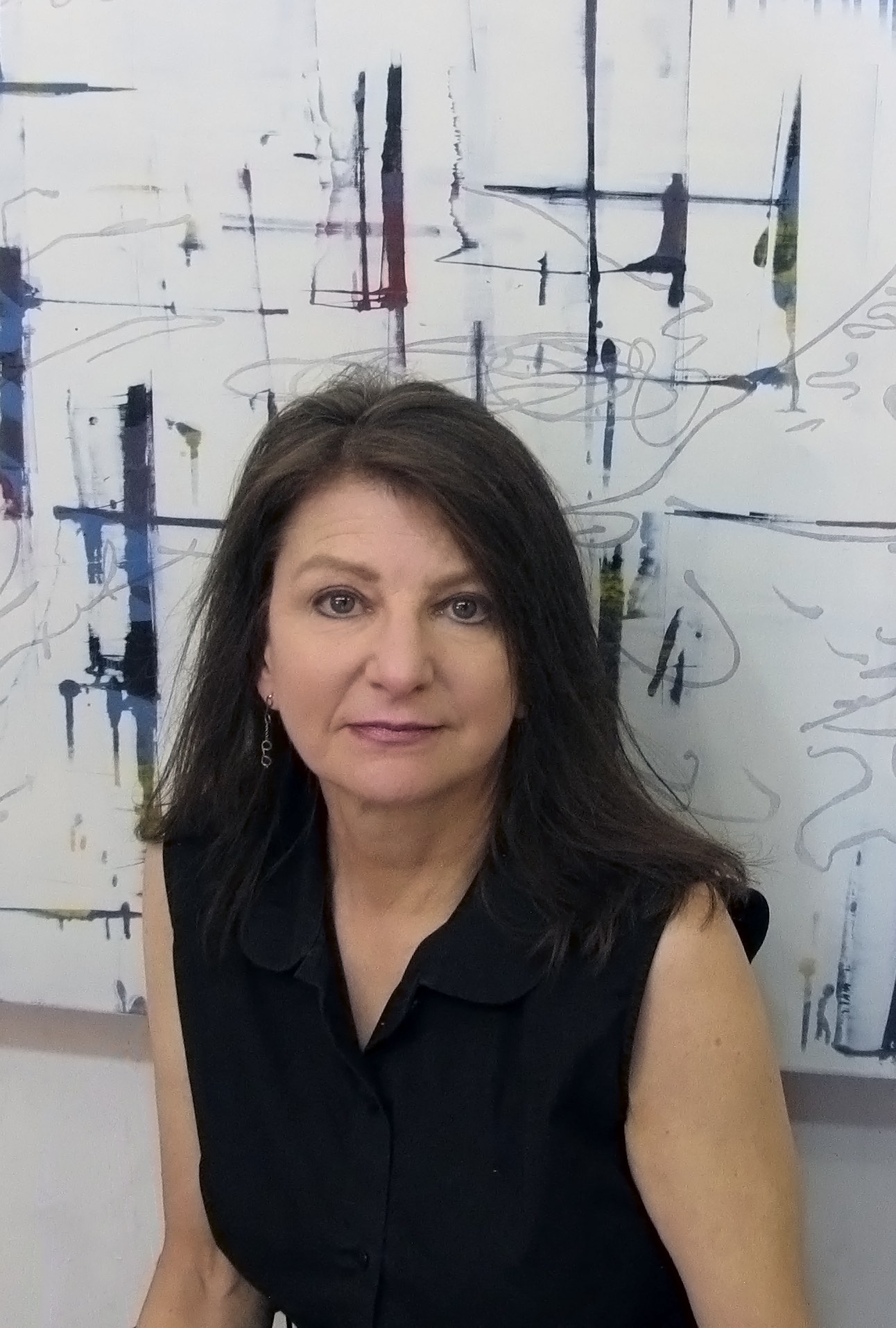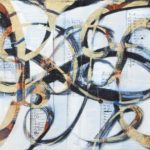Uncategorized
Catherine Courtenaye: Exploring the abstraction of language
Published
7 years agoon
Posted By
Outlaw Partners
By Sarah Gianelli EBS Associate Editor
BOZEMAN – Is it possible to see a word without translating its meaning? That question has long underpinned the work of Bozeman artist Catherine Courtenaye.
Twenty years ago, Courtenaye, a 2017 recipient of the Montana Arts Council Artist’s Innovation Award, came across handwritten correspondence from the 19th century that changed the way she looked at the world.
While in college in Maine, Courtenaye became very interested in the Shakers, a Christian sect founded in 18th century England renowned for its signature spare aesthetic in architecture and furnishings.
During her research, she came across pages of Shaker correspondence. “The look of those letters … I wasn’t even reading the words,” she said. “They just leapt off the page.”
While that may be how Courtenaye started incorporating facsimiles of 19th century penmanship into her abstract paintings, her intrigue with the shape and formation of letters and words—more so than their content—dates back even further.
The daughter of a diplomat, Courtenaye was born in Madrid, Spain, and grew up all around the world.
She went to high school in Tangier, Morocco, where, she said, “the ‘look’ of illegible Arabic signage was perhaps my first awakening to the abstract power of line.”
Courtenaye becomes audibly passionate about penmanship, the ancient origins of language and its historical—and modern day—implications.
The artist is particularly interested in the handwriting of the 19th century for a multitude of reasons. In the scrawls of that era, she finds a visible tension between the forced conformity of proper penmanship, and the subtle expressions of individuality, frowned upon as they were, attempting to break free from those rigid confines. This tension, while definitive of the Victorian era, is also at play in Courtenaye’s work.
“A lot of my work has dealt with this tension between the correct way to make a stroke and my personal accidents of paint,” she said.
As she dug deeper into historical archives, Courtenaye remembers coming across a particular handwritten letter.
“I was suddenly awestruck by how a single pen stroke can conjure an era so keenly,” Courtenaye said. “It communicates the 19th century through the shape of the letterforms, the quality of the strokes, the inkblots and stray marks—one does not see inkblots and stray marks in emails. It is a much more intimate form of communication because it’s flowing from the hand.”
Clearly a history buff, Courtenaye explained that in the 18th century, handwriting style signaled the writer’s gender, social class, profession, and often, the very decade in which it was penned. In the 19th century, when a grassroots effort made penmanship training accessible to all, good penmanship demonstrated that the writer was disciplined, self-restrained, and virtuous.
“For me, this phenomenon of line gets to the heart of visual expression,” the artist said. “Even though handwriting style was rigidly dictated, it’s still a form of drawing.”
In this way, Courtenaye uses handwritten text as another form of abstract imagery, a counter point of line that adds depth and definition to an atmospheric field of color.


Courtenaye incorporates facsimilies of historical penmanship into highly contemporary, abstract works of art. PHOTO BY ROB WILKE
Today, bits and pieces of letterforms peek out from layers of paint, and her subject matter has expanded to include purely abstracted gestures of penmanship, pen-and-ink drawings of birds, avian migration patterns, maps of the Earth’s magnetic field, and aerial landscape views.
Courtenaye also strives to keep her work relevant.
“Even though I am using antique sources, these are contemporary paintings,” she said.
A recent series, selections from which are on display at Big Sky’s Gallatin River Gallery, employs texting acronyms.
For works like “KHYF” (know how you feel) and “RBTL” (read between the lines) Courtenaye laid down big, broad, swooshing strokes, using the stripped-down text as a compositional framework.
“This group of paintings magnifies intimate hand-drawn marks into more explosive gestures,” she said.
The bold brushy lines, derived from cursive script, become conduits of space, providing glimpses into the many strata that lie beneath the surface of each painting.
Courtenaye’s hope is people will see abstraction before legibility in her paintings—and that it will encourage viewers to slow down and take time to read between the lines.
Courtenaye’s work can be seen locally at Gallatin River Gallery in Big Sky. Visit gallatinrivergallery.com or catherinecourtenaye.com for more information.
The Outlaw Partners is a creative marketing, media and events company based in Big Sky, Montana.


Upcoming Events
november, 2024
Event Type :
All
All
Arts
Education
Music
Other
Sports
Event Details
Spanish Classes with World Language InitiativeThese unique, no cost Spanish classes are made possible by the contribution of Yellowstone Club
more
Event Details
Spanish Classes with World Language InitiativeThese unique, no cost Spanish classes are made possible by the contribution of Yellowstone Club Community Foundation (YCCF) and Moonlight Community Foundation (MCF). This class will focus on building a lifelong affinity for world languages and cultures through dynamic and immersive Communicative Language teaching models.
Beginner Class – Mondays and Wednesdays from 5:30-6:30 pm
Intermediate Class – Mondays and Wednesdays from 6:45- 7:45 pm
- Classes begin Oct.7, 2024 and run for 6 weeks
- Class size is limited to 12 students
- Classes are held in Big Sky at the Big Sky Medical Center in the Community Room
For more information or to register follow the link below or at info@wlimt.org.
Time
October 21 (Monday) 5:30 pm - November 27 (Wednesday) 7:45 pm
Location
Big Sky Medical Center - Community Room (2nd Floor)
Big Sky Medical Center - Community Room (2nd Floor)
Event Details
Spanish Classes with World Language InitiativeThese unique, no cost Spanish classes are made possible by the contribution of Yellowstone Club
more
Event Details
Spanish Classes with World Language InitiativeThese unique, no cost Spanish classes are made possible by the contribution of Yellowstone Club Community Foundation (YCCF) and Moonlight Community Foundation (MCF). This class will focus on building a lifelong affinity for world languages and cultures through dynamic and immersive Communicative Language teaching models.
Beginner Class – Mondays and Wednesdays from 5:30-6:30 pm
Intermediate Class – Mondays and Wednesdays from 6:45- 7:45 pm
- Classes begin Oct.7, 2024 and run for 6 weeks
- Class size is limited to 12 students
- Classes are held in Big Sky at the Big Sky Medical Center in the Community Room
For more information or to register follow the link below or at info@wlimt.org.
Time
October 28 (Monday) 5:30 pm - December 4 (Wednesday) 7:45 pm
Location
Big Sky Medical Center - Community Room (2nd Floor)
Big Sky Medical Center - Community Room (2nd Floor)
Event Details
Spanish Classes with World Language InitiativeThese unique, no cost Spanish classes are made possible by the contribution of Yellowstone Club
more
Event Details
Spanish Classes with World Language InitiativeThese unique, no cost Spanish classes are made possible by the contribution of Yellowstone Club Community Foundation (YCCF) and Moonlight Community Foundation (MCF). This class will focus on building a lifelong affinity for world languages and cultures through dynamic and immersive Communicative Language teaching models.
Beginner Class – Mondays and Wednesdays from 5:30-6:30 pm
Intermediate Class – Mondays and Wednesdays from 6:45- 7:45 pm
- Classes begin Oct.7, 2024 and run for 6 weeks
- Class size is limited to 12 students
- Classes are held in Big Sky at the Big Sky Medical Center in the Community Room
For more information or to register follow the link below or at info@wlimt.org.
Time
November 4 (Monday) 5:30 pm - December 11 (Wednesday) 7:45 pm
Location
Big Sky Medical Center - Community Room (2nd Floor)
Big Sky Medical Center - Community Room (2nd Floor)









